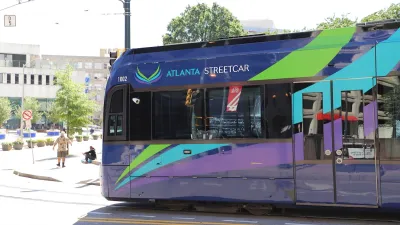The American Institute of Architects will visit Atlanta this year, a month after the 150th anniversary of the end of the Civil War. What should we know about the city as it exists today?
Ahead of the 2015 AIA National Convention, to be held this May in Atlanta, Rebecca Burns introduces Atlanta's current explosive growth and urban renaissance by first noting the metropolitan area's sprawling growth patters, driven by the automobile, since the beginning of the 20th century.
Writes Burns:
"With no natural boundaries, metro Atlanta sprawled, fueled by a population that doubled from 2 million in 1980 to 4 million in 2000, and has continued to surge in this millennium. With 28 counties spread over 8,400 square miles, today’s Atlanta metro region occupies a larger land mass than the combined states of Connecticut and Rhode Island."
But the pendulum has swung, according to Burns:
"Frustrated with sitting in traffic, development patterns driven by subdivisions, and a car-centric culture, a growing number of metro Atlantans are going back to the future by seeking out the compact development patterns of the city’s early history."
For evidence of Atlanta's newest transformation, Burns discusses the BeltLine and a walkable suburban development called Avalon, located 27 miles north of Downtown Atlanta.
The article also includes a long set of images, renderings, and site studies showing the transformation of the BeltLine into an active recreation and transportation corridor.
FULL STORY: AIA Design: Welcome to the Boomtown

Alabama: Trump Terminates Settlements for Black Communities Harmed By Raw Sewage
Trump deemed the landmark civil rights agreement “illegal DEI and environmental justice policy.”

Planetizen Federal Action Tracker
A weekly monitor of how Trump’s orders and actions are impacting planners and planning in America.

How Atlanta Built 7,000 Housing Units in 3 Years
The city’s comprehensive, neighborhood-focused housing strategy focuses on identifying properties and land that can be repurposed for housing and encouraging development in underserved neighborhoods.

In Both Crashes and Crime, Public Transportation is Far Safer than Driving
Contrary to popular assumptions, public transportation has far lower crash and crime rates than automobile travel. For safer communities, improve and encourage transit travel.

Report: Zoning Reforms Should Complement Nashville’s Ambitious Transit Plan
Without reform, restrictive zoning codes will limit the impact of the city’s planned transit expansion and could exclude some of the residents who depend on transit the most.

Judge Orders Release of Frozen IRA, IIJA Funding
The decision is a victory for environmental groups who charged that freezing funds for critical infrastructure and disaster response programs caused “real and irreparable harm” to communities.
Urban Design for Planners 1: Software Tools
This six-course series explores essential urban design concepts using open source software and equips planners with the tools they need to participate fully in the urban design process.
Planning for Universal Design
Learn the tools for implementing Universal Design in planning regulations.
Caltrans
Smith Gee Studio
Institute for Housing and Urban Development Studies (IHS)
City of Grandview
Harvard GSD Executive Education
Toledo-Lucas County Plan Commissions
Salt Lake City
NYU Wagner Graduate School of Public Service





























